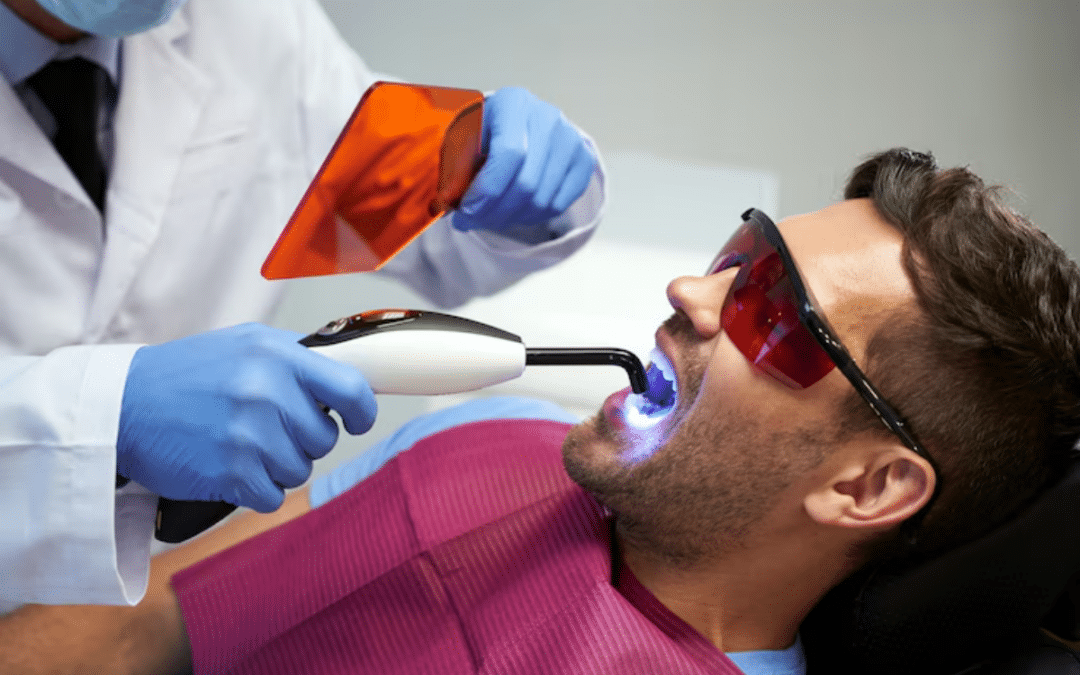Have you ever wondered if there’s a less invasive way to handle dental treatments?
Laser dentistry might be the answer. This innovative approach is transforming how we think about dental care, offering a modern twist on traditional methods. With advancements in technology, lasers are becoming a key player in delivering precise, comfortable, and efficient treatments.
Laser dentistry isn’t just a buzzword—it’s changing the landscape of dental care by minimizing discomfort and speeding up recovery times. Imagine a visit to the dentist where procedures are less painful, and healing is quicker.
Curious about how lasers work in dental treatments and what benefits they bring?
Let’s dive into the world of laser dentistry and explore how it could shape the future of minimally invasive dental care.
What is Laser Dentistry?
Laser dentistry uses focused light beams to perform various dental procedures. Unlike traditional tools, lasers offer a precision that can transform your dental experience. Let’s break down how it works and what makes it unique.
Definition and Technology:
- Laser: Short for Light Amplification by Stimulated Emission of Radiation, it uses light to target specific tissues.
- How It Works: Lasers emit light beams that interact with tissues in your mouth, making precise cuts or treatments without needing physical contact.
Types of Lasers Used in Dentistry:
- Soft Tissue Lasers: Ideal for gum treatments and soft tissue surgeries. They help with procedures like gum reshaping and treatment of gum disease.
- Hard Tissue Lasers: Used for cavity preparation and tooth enamel removal. They are effective in procedures involving hard dental tissues.
Lasers offer a modern approach to dental care, providing more control and potentially better outcomes for patients.
Advantages of Laser Dentistry
Laser dentistry comes with several benefits that make it an appealing choice for many patients. These advantages make laser treatments stand out from traditional methods.
Minimally Invasive Nature:
- Precision: Lasers target specific areas, reducing damage to surrounding tissues.
- Less Trauma: The precision minimizes the need for anesthesia and reduces the overall trauma to the treated area.
Reduced Pain and Faster Healing:
- Less Discomfort: Many patients report less pain during and after procedures compared to traditional methods.
- Quick Recovery: The healing time is often shorter, thanks to reduced tissue damage and inflammation.
Precision and Accuracy:
- Enhanced Control: Dentists can perform highly accurate procedures, which can lead to better outcomes and fewer complications.
- Detailed Work: The precision allows for more detailed and intricate dental work, improving the overall quality of treatment.
Common Applications of Laser Dentistry
Laser technology finds its way into various dental treatments, offering solutions that can be less invasive and more efficient. Here’s how lasers are used in everyday dental care.
Treatment of Cavities:
- Decay Removal: Lasers can remove decayed tissue without affecting healthy parts of the tooth.
- Minimized Discomfort: Often, this procedure requires less anesthesia and causes less discomfort compared to traditional drills.
Gum Disease Management:
- Gum Reshaping: Lasers help in reshaping gum tissues, which is useful in treating gum overgrowth or receding gums.
- Bacterial Reduction: The laser can also help reduce bacteria in infected gum tissues, promoting healing.
Cosmetic Procedures:
- Teeth Whitening: Lasers can speed up the whitening process and enhance the effectiveness of whitening agents.
- Gum Contouring: Lasers are used to improve the appearance of gums by removing excess tissue and reshaping the gum line.
Comparisons with Traditional Dental Methods
Understanding how laser dentistry compares to traditional methods can help you see why lasers are gaining popularity.
Differences in Procedures:
- Laser vs. Drill: Lasers are often quieter and less invasive compared to traditional drills, which can reduce anxiety and discomfort.
- Accuracy: Lasers offer more precision in targeting specific tissues without affecting nearby areas.
Pros and Cons of Laser vs. Traditional Methods:
- Pros: Less pain, reduced need for anesthesia, and quicker recovery times are major advantages.
- Cons: Not all procedures are suitable for lasers, and some may require traditional methods for optimal results.
Patient Experience and Safety
Patient comfort and safety are top priorities in any dental procedure. Laser dentistry aims to enhance both aspects through advanced technology.
Comfort During Treatments:
- Reduced Pain: Many patients experience less pain during laser treatments compared to traditional methods.
- Less Need for Anesthesia: Due to the precision and reduced trauma, laser procedures often require less or no anesthesia.
Safety Measures and Considerations:
- Safety Protocols: Dentists follow strict safety protocols to protect patients from potential risks associated with laser use.
- Training and Expertise: Ensuring that your dentist is well-trained in laser technology is crucial for achieving the best results and maintaining safety.
The Future of Laser Dentistry
As technology evolves, laser dentistry continues to advance, offering promising possibilities for the future of dental care.
Emerging Trends and Technologies:
- New Laser Types: Ongoing research is developing new types of lasers for more applications and improved outcomes.
- Integration with Other Technologies: Combining lasers with other advanced technologies may enhance treatment effectiveness and patient comfort.
Potential Developments in Minimally Invasive Care:
- Expanded Applications: Future advancements may broaden the range of conditions that can be treated with lasers.
- Enhanced Precision: Improved laser technology could offer even greater precision and control, making dental treatments more effective and less invasive.
Laser dentistry represents a significant leap forward in minimally invasive dental care. Its precision, reduced discomfort, and quicker recovery times make it an exciting option for many dental procedures. As technology continues to evolve, laser dentistry is likely to become even more integral to modern dental practices. If you’re curious about this innovative approach, discuss it with your dentist to see how it might benefit your oral health and enhance your overall dental experience.

